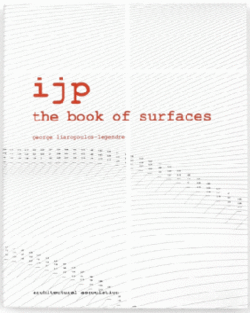IJP The Book of Surfaces
 Book cover | |
| Author | George L. Legendre |
|---|---|
| Language | English |
| Publisher | AA Publications |
Publication date | March 2003 |
| ISBN | ISBN:1-902902-32-7 |
| Text | IJP The Book of Surfaces online |
IJP the book of surfaces is a book by George L. Legendre, with a foreword by Mohsen Mostafavi.
Overview
IJP the Book of Surfaces was released in 2003 by the publishing arm of the London-based Architectural Association School of Architecture. The book features six essays on the notion of surface written from an architectural, philosophical, literary, mathematical, and computational angle, as well as several lighter asides ranging from cookery to poetry. These threads have been given a particular typographic and graphic design treatment meant to weave them together into a continuous narrative.[1]
Background and literary references
The book addresses some significant developments of the decade, such as the explosion of computational tools; the emergence of the 3D surface as an architectural signifier of the Digital Revolution;[2] the profession's fascination with the formal possibilities of surface cladding; and the rise of innovative manufacturing technologies. It can be compared to contemporary titles like Mohsen Mostafavi’s and David Leatherbarrow’s Surface Architecture,[3] an essay on the phenomenology of architectural façades, and Ellen Lupton’s collection Skin: Surface, Substance + Design, which explores the working metaphor of artificial skin in Materials science, fashion and the visual arts.[4] By comparison, Illa Berman notes that IJP the Book of Surfaces withdraws from external cultural currents and their contexts and emerges from within the formal and computational specificity of the surface itself.[5] As a piece of writing, it is indebted to the literary school Oulipo. Its treatment of one theme as a collection of vignettes written in different voices (linguistic, mathematical, computational, mock-literary, and pop-cultural) nods back to Raymond Queneau’s 1947 Exercises in Style, in which the same trivial event is told and re-told in different idioms.[6]
Form and content
In keeping with the literary/mathematical spirit of Oulipo, layout, typography, and pagination form an integral part of the book's thesis. The pagination taps the formal affinity between a publisher’s book spread and a mathematician's surface, both of which draw on the concept of mathematical matrix. Similar mathematical references apply to the title of the work, which combines 'i' and 'j', two symbols commonly used in matrix algebra, with the symbol 'p' (for point), introduced by the author in reference to Euclidean space.[7]
Reception
The book’s argument and restrained use of computer graphics by the standards of the day (dominated then as now by computer-generated renderings[8]) elicited a mixed reception. Historians and theorists[9] noted its withdrawal from the wider cultural context,[10] its consistent argument,[11] graphic sobriety,[12] and theoretical reach.[13] Some readers noted its lack of engagement with other pressing issues of the day, such as sustainability and ecology, as well as its blank and solipsistic tone, occasionally questionable syntax, and pedestrian graphic design.[14] The book's reception may have reflected disagreements in the architectural community at the time over the meaning of innovation and the finality of computational tools. After 2015, similar disagreements arose between the trade press[15] and the self-identifying avant-garde movement of architectural parametricism. Legendre has since distanced himself from the broader cultural claims of the movement[16]).
References
- ↑ George L. Legendre (2003) IJP The Book of Surfaces, AA Publications London, out of print
- ↑ Mauro Chiarella Parametric Surfaces And Architecture: Concepts, Design, and Production CAADRIA 2005 Proceedings of the 10th International Conference The Association for Computer-Aided Architectural Design Research in Asia
- ↑ Mohsen Mostafavi and David Leatherbarrow (2005) Surface Architecture MIT Press ISBN 9780262621946
- ↑ Ellen Lupton, Editor (2002) Skin: Surface, Substance + Design Princeton Architectural Press and Cooper Hewitt, Smithsonian Design Museum
- ↑ Illa Berman (2003) THICK SKINS: The Complexity of the Superficial in Journal of Architectural Education Volume 57, 2003 - Issue 2
- ↑ Tom Weaver, Eds (2007) George L Legendre in Conversation with Hans Ulrich Obrist (2007) AA Files No. 56 (2007), pp. 20-25 (6 pages)
- ↑ George L. Legendre (2003), page 3,12
- ↑ From Autodesk 3ds Max in the 1990s to Midjourney in 2022, the emphasis on imaging remains. For the latest trends, see Tim Fu (2022) Dreaming up viable parametric creations: Working through the chaos of AI in Parametric Architecture
- ↑ Antoine Picon (2010) Continuity, Complexity, and Emergence: What is the Real for Digital Designers? in Perspecta Vol. 42, pp. 147-157 (11 pages) The MIT Press
- ↑ Illa Berman (2003) THICK SKINS: The Complexity of the Superficial in Journal of Architectural Education Volume 57, 2003 - Issue 2
- ↑ Peter Carl (2003) On the Poetry of Matrices in Architectural Research Quarterly, 7, pp 371372 doi:10.1017/S1359135503212306
- ↑ Peter Carl (2003) The comforting, erotic smoothness of the preferred surface-profiles is the offspring of a regime of abstract, relentless calculation. The curves are rarely presented without evidence of the sober pulses of computation.
- ↑ Antoine Picon (2010) P. 152 More than volumes, surfaces seem to bear the mark of the computer processes that generate them, a point made clear by Georges L. Legendre in his essay IJP : The Book of Surfaces . Whereas volumes seem arbitrary or somewhat opaque and inert, surfaces appear as more genuine expressions of parametric variation. In other words, surfaces are more naturally animated
- ↑ Neil Spiller (2003) The Number's Up Review of IJP The Book of Surfaces Building Design Magazine, issue 1588 London.] There is much that is missed in this oddly narcissistic book (...) a few more pages go on equations defining surfaces of little use to academic or even jobbing architects.
- ↑ The Most Convincing Argument Against Parametric Design Yet by Meg Miller (2016) in Fast Company
- ↑ Tom Weaver, Eds (2007) George L Legendre in Conversation with Hans Ulrich Obrist (2007) AA Files No. 56 (2007), pp. 20-25 (6 pages)
 |

